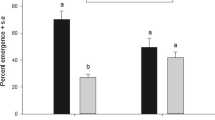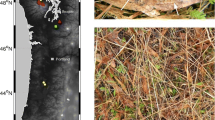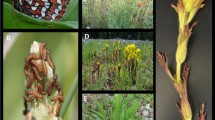Abstract
Intra- and interspecific resource competition are potentially important factors affecting host plant use by phytophagous insects. In particular, escape from competitors could mediate a successful host shift by compensating for decreased feeding performance on a new plant. Here, we examine the question of host plant-dependent competition for apple (Malus pumila)- and hawthorn (Crataegus mollis)-infesting larvae of the apple maggot fly, Rhagoletis pomonella (Diptera: Tephritidae) at a field site near Grant, Michigan, USA. Interspecific competition from tortricid (Cydia pomonella, Grapholita prunivora, and Grapholita packardi) and agonoxenid (subfamily Blastodacninae) caterpillars and a curculionid weevil (Conotrachelus crataegi) was much stronger for R. pomonella larvae infesting the ancestral host hawthorn than the derived host apple. Egg to pupal survivorship was estimated as 52.8% for fly larvae infesting hawthorn fruit without caterpillars and weevils compared to only 27.3% for larvae in harthorns with interspecific insects. Survivorship was essentially the same between fly larvae infesting apples in the presence (44.8%) or absence (42.6%) of interspecific insects. Intraspecific competition among maggots was also stronger in hawthorns than apples. The order or time that a larva exited a hawthorn fruit was a significant determinant of its pupal mass, with earlier emerging larvae being heavier than later emerging larvae. This was not the case for larvae in apples, as the order or time that a larva exited an apple fruit had relatively little influence on its pupal mass. Our findings suggest that decreased performance related to host plant chemistry/nutrition may restrict host range expansion and race formation in R. pomonella to those plants where biotic/ecological factors (i.e. escape from competitors and parasitoids) adequately balance the survivorship equation. This balance permits stable fly populations to persist on novel plants, setting the stage for the evolution of host specialization under certain mitigating conditions (e.g. when mating is host specific and host-associated fitness trade-offs exist).
Similar content being viewed by others
References
Averill AL, Prokopy RJ (1987) Intraspecific competition in the Tephritid fruit fly Rhagoletis pomonella. Ecology 68:878–886
Averill AL, Prokopy RJ (1989) Distribution patterns of Rhagoletis pomonella (Diptera:Tephritidae) eggs in hawthorn. Ann Entomol Soc Am 82:38–44
Bernays E, Graham M (1988) On the evolution of host specificity in phytophagous arthropods. Ecology 69:886–892
Boller EF, Prokopy RJ (1976) Bionomics and management of Rhagoletis. Annu Rev Entomol 21:223–246
Brittian WH, Good CA (1917) The apple maggot of Nova Scotia. Nova Scotia Dept Agric Bull 9
Bush GL (1969a) Sympatric host race formation and speciation in frugivorous flies of the genus Rhagoletis (Diptera:Tephritidae). Evolution 23:237–251
Bush GL (1969b) Mating behavior, host specificity, and the ecological significance of sibling species in frugivorous flies of the genus Rhagoletis (Diptera:Tephritidae). Am Nat 103:669–672
Bush GL (1975) Modes of animal speciation. Annu Rev Ecol Syst 6:339–364
Bush GL, Howard DJ (1986) Allopatric and non-allopatric speciation; assumptions and evidence. In: Karlin S, Nevo E (eds) Evolutionary processes and theory. Academic Press, New York, pp 411–438
Cameron PJ, Morrison FO (1977) Analysis of mortality in the Apple Maggot, Rhagoletis pomonella (Diptera:Tephritidae), in Quebec. Can Entomol 109:769–788
Dean RW, Chapman PJ (1973) Bionomics of the apple maggot in eastern New York. Search Agric Entomol Geneva no. 3, Geneva, NY
Diehl SR, Bush GL (1989) The role of habitat preference in adaptation and speciation. In: Otte D, Endler JA (eds) Speciation and its consequences. Sinauer, Sunderland, Mass, pp 345–365
Dirks CO (1935) Larval production and adult emergence of the apple maggot fly in relation to apple varieties. J Econ Entomol 28:198–203
Ehrlich PR, Raven PH (1964) Butterflies and plants: a study in coevolution. Evolution 18:586–608
Feder JL (1995) The effects of parasitoids on sympatric host races of the Apple Maggot Fly, Rhagoletis pomonella (Diptera:Tephritidae). Ecology (in press)
Feder JL, Bush GL (1989) Gene frequency clines for host races of Rhagoletis pomonella (Diptera:Tephritidae) in the midwestern United States. Heredity 63:245–266
Feder JL, Chilcote CA, Bush GL (1988) Genetic differentiation between sympatric host races of the apple maggot fly Rhagoletis pomonella. Nature 336:61–64
Feder JL, Chilcote CA, Bush GL (1990) Geographic pattern of genetic differentiation between host associated populations of Rhagoletis pomonella (Diptera:Tephritidae) in the eastern United States and Canada. Evolution 44:570–594
Feder JL, Hunt TA, Bush GL (1993) The effects of climate, host phenology and host fidelity on the genetics of apple and hawthorn infesting populations of Rhagoletis pomonella (Diptera: Tephritidae). Entomol Exp Appl 69:117–135
Feder JL, Opp S, Wlazlo B, Reynolds K, Go W, Spisak S (1994) Host fidelity is an effective pre-mating barrier between sympatric races of the Apple Maggot Fly, Rhagoletis pomonella. Proc Natl Acad Sci USA 91:7990–7994
Futuyma DJ, Keese MC, Scheffer SJ (1993) Genetic constraints and the phylogeny of insect-plant associations: responses of Ophraella communa (Coleoptera, Chrysomelidae) to host plants of its congeners. Evolution 47:888–905
Gilbert LE, Singer MC (1975) Butterfly ecology. Annu Rev Ecol Syst 6:365–397
Hairston NG, Smith FE, Slobodkin LB (1960) Community structure, population control and competition. Am Nat 94:421–425
Jaenike J (1990) Host specialization in phytophagous insects. Annu Rev Ecol Syst 21:243–273
Jeffries MJ, Lawton JH (1984) Enemy-free space and the structure of biological communities. Biol J Linn Soc 23:269–286
Maynard Smith J (1966) Sympatric speciation. Am Nat 100:637–650
McPheron BA, Smith DC, Berlocher SH (1988) Genetic differences between Rhagoletis pomonella host races. Nature 336:64–66
Phipps CR, Dirks CO (1933) Notes on the biology of the apple maggot fly. J Econ Entomol 26:349–358
Pimm SL (1979) Sympatric speciation: a simulation model. Biol J Linn Soc 11:131–139
Prokopy RJ, Bennett EW, Bush GL (1971) Mating behavior in Rhagoletis pomonella (Diptera:Tephritidae). I. Site of assembly. Can Entomol 103:1405–1409
Prokopy RJ, Bennett EW, Bush GL (1972) Mating behavior in Rhagoletis pomonella (Diptera:Tephritidae). II. Temporal organization. Can Entomol 104:97–104
Prokopy RJ, Diehl SR, Cooley SS (1988) Behavioral evidence for host races in Rhagoletis pomonella flies. Oecologia 76:138–147
Rausher MD (1984) The evolution of habitat preference in subdivided populations. Evolution 38:596–608
Reissig WH (1979) Survival of apple maggot larvae, Rhagoletis pomonella (Diptera:Tephritidae), in picked and unpicked apples. Can Entomol 111:181–187
Rosenzweig ML (1978) competitive speciation. Biol J Linn Soc 10:275–289
Rosenzweig ML (1987) Habitat selection as a source of biological diversity. Evol Ecol 1:315–330
Rosenzweig ML (1991) Habitat selection and population interactions: the search for mechanisms. Am Nat 137:S5-S28
Rice WR (1984) Disruptive selection on habitat preference and the evolution of reproductive isolation: a simulation study. Evolution 38:1251–1260
Rice WR (1987) Speciation via habitat specialization. Evol Ecol 1:301–314
Smith DC (1988) Heritable divergence of Rhagoletis pomonella host races by seasonal asynchrony. Nature 336:66–67
Walsh BJ (1864) On phytophagous varieties and phytophagous species. Proc Entomol Soc Philadelphia 3:403–430
Walsh BJ (1867) The apple-worm and the apple maggot. J Hort 2:338–343
Wilson DS (1989) The diversification of single gene pools by density-and frequency-dependent selection. In: Otte D, Endler JA (eds) Speciation and its consequences. Sinauer, Sunderland, Mass, pp 366–385
Wilson DS, Turelli M (1986) Stable underdominance and the evolutionary invasion of empty niches. Am Nat 127:835–850
Author information
Authors and Affiliations
Corresponding author
Rights and permissions
About this article
Cite this article
Feder, J.L., Reynolds, K., Go, W. et al. Intra- and interspecific competition and host race formation in the apple maggot fly, Rhagoletis pomonella (Diptera: Tephritidae). Oecologia 101, 416–425 (1995). https://doi.org/10.1007/BF00329420
Received:
Accepted:
Issue Date:
DOI: https://doi.org/10.1007/BF00329420




